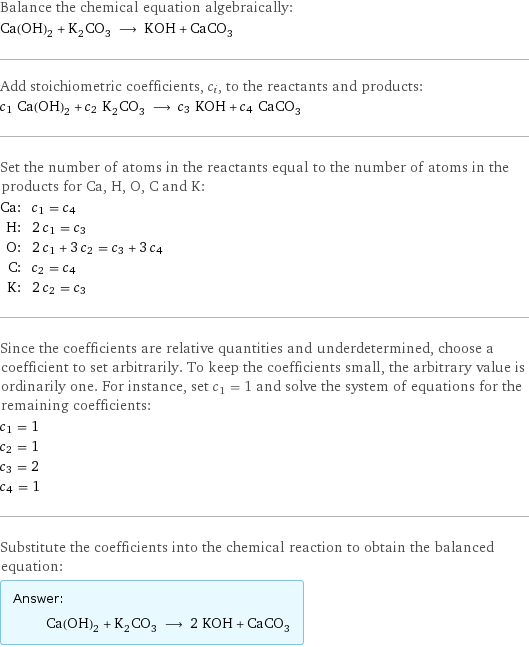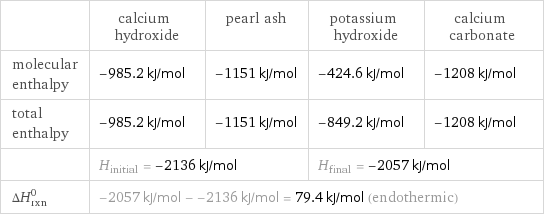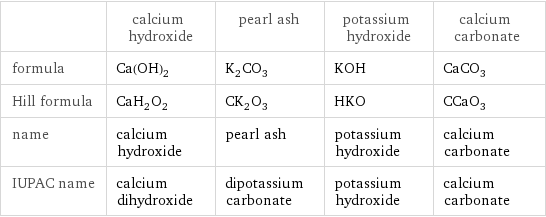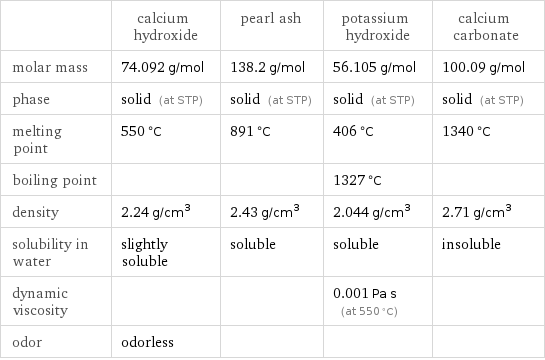Input interpretation

Ca(OH)_2 calcium hydroxide + K_2CO_3 pearl ash ⟶ KOH potassium hydroxide + CaCO_3 calcium carbonate
Balanced equation

Balance the chemical equation algebraically: Ca(OH)_2 + K_2CO_3 ⟶ KOH + CaCO_3 Add stoichiometric coefficients, c_i, to the reactants and products: c_1 Ca(OH)_2 + c_2 K_2CO_3 ⟶ c_3 KOH + c_4 CaCO_3 Set the number of atoms in the reactants equal to the number of atoms in the products for Ca, H, O, C and K: Ca: | c_1 = c_4 H: | 2 c_1 = c_3 O: | 2 c_1 + 3 c_2 = c_3 + 3 c_4 C: | c_2 = c_4 K: | 2 c_2 = c_3 Since the coefficients are relative quantities and underdetermined, choose a coefficient to set arbitrarily. To keep the coefficients small, the arbitrary value is ordinarily one. For instance, set c_1 = 1 and solve the system of equations for the remaining coefficients: c_1 = 1 c_2 = 1 c_3 = 2 c_4 = 1 Substitute the coefficients into the chemical reaction to obtain the balanced equation: Answer: | | Ca(OH)_2 + K_2CO_3 ⟶ 2 KOH + CaCO_3
Structures

+ ⟶ +
Names

calcium hydroxide + pearl ash ⟶ potassium hydroxide + calcium carbonate
Reaction thermodynamics
Enthalpy

| calcium hydroxide | pearl ash | potassium hydroxide | calcium carbonate molecular enthalpy | -985.2 kJ/mol | -1151 kJ/mol | -424.6 kJ/mol | -1208 kJ/mol total enthalpy | -985.2 kJ/mol | -1151 kJ/mol | -849.2 kJ/mol | -1208 kJ/mol | H_initial = -2136 kJ/mol | | H_final = -2057 kJ/mol | ΔH_rxn^0 | -2057 kJ/mol - -2136 kJ/mol = 79.4 kJ/mol (endothermic) | | |
Gibbs free energy

| calcium hydroxide | pearl ash | potassium hydroxide | calcium carbonate molecular free energy | -897.5 kJ/mol | -1064 kJ/mol | -379.4 kJ/mol | -1129 kJ/mol total free energy | -897.5 kJ/mol | -1064 kJ/mol | -758.8 kJ/mol | -1129 kJ/mol | G_initial = -1961 kJ/mol | | G_final = -1888 kJ/mol | ΔG_rxn^0 | -1888 kJ/mol - -1961 kJ/mol = 73.1 kJ/mol (endergonic) | | |
Equilibrium constant
![Construct the equilibrium constant, K, expression for: Ca(OH)_2 + K_2CO_3 ⟶ KOH + CaCO_3 Plan: • Balance the chemical equation. • Determine the stoichiometric numbers. • Assemble the activity expression for each chemical species. • Use the activity expressions to build the equilibrium constant expression. Write the balanced chemical equation: Ca(OH)_2 + K_2CO_3 ⟶ 2 KOH + CaCO_3 Assign stoichiometric numbers, ν_i, using the stoichiometric coefficients, c_i, from the balanced chemical equation in the following manner: ν_i = -c_i for reactants and ν_i = c_i for products: chemical species | c_i | ν_i Ca(OH)_2 | 1 | -1 K_2CO_3 | 1 | -1 KOH | 2 | 2 CaCO_3 | 1 | 1 Assemble the activity expressions accounting for the state of matter and ν_i: chemical species | c_i | ν_i | activity expression Ca(OH)_2 | 1 | -1 | ([Ca(OH)2])^(-1) K_2CO_3 | 1 | -1 | ([K2CO3])^(-1) KOH | 2 | 2 | ([KOH])^2 CaCO_3 | 1 | 1 | [CaCO3] The equilibrium constant symbol in the concentration basis is: K_c Mulitply the activity expressions to arrive at the K_c expression: Answer: | | K_c = ([Ca(OH)2])^(-1) ([K2CO3])^(-1) ([KOH])^2 [CaCO3] = (([KOH])^2 [CaCO3])/([Ca(OH)2] [K2CO3])](../image_source/7be93835f959977ce987663a9ec813e3.png)
Construct the equilibrium constant, K, expression for: Ca(OH)_2 + K_2CO_3 ⟶ KOH + CaCO_3 Plan: • Balance the chemical equation. • Determine the stoichiometric numbers. • Assemble the activity expression for each chemical species. • Use the activity expressions to build the equilibrium constant expression. Write the balanced chemical equation: Ca(OH)_2 + K_2CO_3 ⟶ 2 KOH + CaCO_3 Assign stoichiometric numbers, ν_i, using the stoichiometric coefficients, c_i, from the balanced chemical equation in the following manner: ν_i = -c_i for reactants and ν_i = c_i for products: chemical species | c_i | ν_i Ca(OH)_2 | 1 | -1 K_2CO_3 | 1 | -1 KOH | 2 | 2 CaCO_3 | 1 | 1 Assemble the activity expressions accounting for the state of matter and ν_i: chemical species | c_i | ν_i | activity expression Ca(OH)_2 | 1 | -1 | ([Ca(OH)2])^(-1) K_2CO_3 | 1 | -1 | ([K2CO3])^(-1) KOH | 2 | 2 | ([KOH])^2 CaCO_3 | 1 | 1 | [CaCO3] The equilibrium constant symbol in the concentration basis is: K_c Mulitply the activity expressions to arrive at the K_c expression: Answer: | | K_c = ([Ca(OH)2])^(-1) ([K2CO3])^(-1) ([KOH])^2 [CaCO3] = (([KOH])^2 [CaCO3])/([Ca(OH)2] [K2CO3])
Rate of reaction
![Construct the rate of reaction expression for: Ca(OH)_2 + K_2CO_3 ⟶ KOH + CaCO_3 Plan: • Balance the chemical equation. • Determine the stoichiometric numbers. • Assemble the rate term for each chemical species. • Write the rate of reaction expression. Write the balanced chemical equation: Ca(OH)_2 + K_2CO_3 ⟶ 2 KOH + CaCO_3 Assign stoichiometric numbers, ν_i, using the stoichiometric coefficients, c_i, from the balanced chemical equation in the following manner: ν_i = -c_i for reactants and ν_i = c_i for products: chemical species | c_i | ν_i Ca(OH)_2 | 1 | -1 K_2CO_3 | 1 | -1 KOH | 2 | 2 CaCO_3 | 1 | 1 The rate term for each chemical species, B_i, is 1/ν_i(Δ[B_i])/(Δt) where [B_i] is the amount concentration and t is time: chemical species | c_i | ν_i | rate term Ca(OH)_2 | 1 | -1 | -(Δ[Ca(OH)2])/(Δt) K_2CO_3 | 1 | -1 | -(Δ[K2CO3])/(Δt) KOH | 2 | 2 | 1/2 (Δ[KOH])/(Δt) CaCO_3 | 1 | 1 | (Δ[CaCO3])/(Δt) (for infinitesimal rate of change, replace Δ with d) Set the rate terms equal to each other to arrive at the rate expression: Answer: | | rate = -(Δ[Ca(OH)2])/(Δt) = -(Δ[K2CO3])/(Δt) = 1/2 (Δ[KOH])/(Δt) = (Δ[CaCO3])/(Δt) (assuming constant volume and no accumulation of intermediates or side products)](../image_source/e07c5ff7c01d75485a261d89c2055c59.png)
Construct the rate of reaction expression for: Ca(OH)_2 + K_2CO_3 ⟶ KOH + CaCO_3 Plan: • Balance the chemical equation. • Determine the stoichiometric numbers. • Assemble the rate term for each chemical species. • Write the rate of reaction expression. Write the balanced chemical equation: Ca(OH)_2 + K_2CO_3 ⟶ 2 KOH + CaCO_3 Assign stoichiometric numbers, ν_i, using the stoichiometric coefficients, c_i, from the balanced chemical equation in the following manner: ν_i = -c_i for reactants and ν_i = c_i for products: chemical species | c_i | ν_i Ca(OH)_2 | 1 | -1 K_2CO_3 | 1 | -1 KOH | 2 | 2 CaCO_3 | 1 | 1 The rate term for each chemical species, B_i, is 1/ν_i(Δ[B_i])/(Δt) where [B_i] is the amount concentration and t is time: chemical species | c_i | ν_i | rate term Ca(OH)_2 | 1 | -1 | -(Δ[Ca(OH)2])/(Δt) K_2CO_3 | 1 | -1 | -(Δ[K2CO3])/(Δt) KOH | 2 | 2 | 1/2 (Δ[KOH])/(Δt) CaCO_3 | 1 | 1 | (Δ[CaCO3])/(Δt) (for infinitesimal rate of change, replace Δ with d) Set the rate terms equal to each other to arrive at the rate expression: Answer: | | rate = -(Δ[Ca(OH)2])/(Δt) = -(Δ[K2CO3])/(Δt) = 1/2 (Δ[KOH])/(Δt) = (Δ[CaCO3])/(Δt) (assuming constant volume and no accumulation of intermediates or side products)
Chemical names and formulas

| calcium hydroxide | pearl ash | potassium hydroxide | calcium carbonate formula | Ca(OH)_2 | K_2CO_3 | KOH | CaCO_3 Hill formula | CaH_2O_2 | CK_2O_3 | HKO | CCaO_3 name | calcium hydroxide | pearl ash | potassium hydroxide | calcium carbonate IUPAC name | calcium dihydroxide | dipotassium carbonate | potassium hydroxide | calcium carbonate
Substance properties

| calcium hydroxide | pearl ash | potassium hydroxide | calcium carbonate molar mass | 74.092 g/mol | 138.2 g/mol | 56.105 g/mol | 100.09 g/mol phase | solid (at STP) | solid (at STP) | solid (at STP) | solid (at STP) melting point | 550 °C | 891 °C | 406 °C | 1340 °C boiling point | | | 1327 °C | density | 2.24 g/cm^3 | 2.43 g/cm^3 | 2.044 g/cm^3 | 2.71 g/cm^3 solubility in water | slightly soluble | soluble | soluble | insoluble dynamic viscosity | | | 0.001 Pa s (at 550 °C) | odor | odorless | | |
Units
